Matt Whitaker
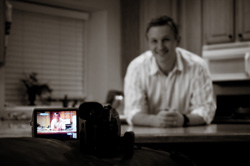
How did you get started in the filmmaking profession? Was it something you always wanted to do?
When I was young I actually wanted to be an actor. Or a movie star. I wanted to be a movie star and if acting was a part of that, then I would do that too. I went to BYU, and when I was a freshman I was actually majoring in drama—in acting. I did that until I went on my mission.
It was while I was a missionary in Paris that I figured out it would be pretty tough to be an active member of the Church and to make a living as an actor. I started thinking about moving to the other side of the camera, so when I got back from my mission I started enrolling in the film program. Back then it was a lot easier than it is now; it’s very competitive now to get into the film program at BYU. I started taking film production classes in ’89 and fell in love with it. I realized that I much preferred being on the other side of the camera.
One of the things that I figured out was that, although I loved acting, I wasn’t that great of an actor. But I found out that I could bring a good, believable performance out of someone else. I really fell in love with that part of the process.
So, I graduated from BYU in film production in 1992. Then I had to work my way up the ladder and start at the bottom as a production assistant. I went down to Los Angeles and did a summer internship for a production company while I was a student at BYU. I worked for free down there, but it has continued to pay dividends. You come back to Utah and say, “I worked in L.A.,” or, “I did this in the film business in L.A.,” and it carries a lot of clout, whether it should or not.
I was very fortunate, very blessed, to get breaks very quickly into the directing field, which was what I wanted to get into—writing and directing. My first professional gig was a little project for the Church. It was actually on parking lot maintenance, how to take care of your church parking lot. You have to start somewhere.
But after that I started doing a lot of seminary films and then branched out and started doing documentaries for PBS. The whole time I was screenwriting. That was kind of like my night job. I would get up early and stay up late and write screenplays and then make movies during the day.
Were the screenplays your own projects, or were they for the same organizations?
A lot of it was my own stuff. Stories that I wanted to tell that were inside of me and had to come out somewhere, so I would write them.
You mentioned that you worked your way from doing things like working as a foley assistant all the way up to writing, directing and producing. What is your favorite hat to wear?
I love the writing process ninety percent of the time. Otherwise, I hate it. I often refer to a quote by another writer named Gene Fowler who said, “Writing is easy. It’s just a matter of staring at the blank page until your forehead bleeds.”
Sometimes it’s like that; I do get writers block. But when I’m not there I absolutely love that process of imagining, of creating something that no one has ever seen before and typing it into a script.
And then if you’re lucky enough or fortunate enough to have that script actually go into production and get made into a film, to see it actually happening is just magic. It’s a rush.
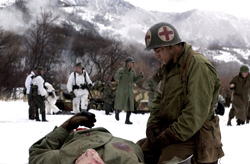
When your role on a project is as a screenwriter, how much does that carry over into the actual filming of what you have created?
It depends on the project. I have been very fortunate in the scripts that I’ve written but haven’t directed because the directors have been very generous and wanted me on set to get my input.
As a screenwriter, you’re constantly doing rewrites—every single day, every single night—while you’re shooting. An actor will say, “What if this scene went this way? In the scene we’re shooting tomorrow, what if I said this, this, and this?” Then the director says, “That’s great.” Hopefully I will get to have my input, but I know my place as a screenwriter. You are invited to the set and if the director asks for your input then you give it, but it’s not my place as a screenwriter to say, “No, it has to be this way,” or, “I wrote it because of this,” or whatever.
When we did the second and third Work and the Glory films I was out there for a lot of that. For Saints and Soldiers I wasn’t able to be there because I was working on another project while they were shooting, although I was invited.
How are projects like The Work and the Glory, which is drawn from source material already in existence, different from something that comes out of your imagination? How do you work with an existing text and how do you change it to make it more appropriate for the screen?
Adapting a novel into a screenplay is a very specific process—and it’s something that I’ve had some experience at. I wasn’t involved in the first Work and the Glory film, so when they asked me to come on for the second and third films the first question that the producer asked was, “Have you read the books?”
I had read all nine of them, actually. But once I took the job, I dove back into the source material. You have to. You read it, and you reread it, and you mark it up, and you’re folding pages.
Any time you have a four-hundred-page book that’s going to turn into a two-hour movie you have to take out a whole lot of stuff. So what I’m looking for when I dive back into it knowing that I’m going to adapt it into a screenplay are the threads that resonate, the threads that will have an arc and carry us through a good two-hour story.
With The Work and the Glory, for instance, so many great threads are weaving all over that. Gerald Lund did a great job weaving together so many different strands and threads and storylines. But I took mainly the father-son/Benjamin-Joshua storyline and really focused on that. A lot of other things, unfortunately, had to fall by the wayside. But it’s finding that thread, and then finding what has to be taken out, what can stay, and what has to be added in.
We’re not filming the book; we’re making a movie based on the book. And it’s a different medium, a different way of telling a story. Usually you end up coming into a movie a lot later than the book. We may start at chapter eight instead of chapter one because that is where the story starts filmically.
I’ve noticed that most of your work so far has been in the Mormon field, geared toward Mormon audiences with themes that are relevant. Is that something you consciously planned or is that the way your career has naturally flowed?
I think that living in Utah dictates that a little bit. A lot of the work that’s in this area has LDS-related themes and stories that people are trying to tell around here. It’s been a great experience, but those are not the only stories I want to tell.
As an LDS filmmaker, it’s been wonderful to be able to tell some of our stories and I plan on telling a lot more of them. But it’s never been my intent to propagandize with this. I’m really all about telling good stories, or trying to tell good stories. And if a story has a theme that relates to my faith, that’s wonderful. If it doesn’t but it’s a great story, that’s wonderful, too. I just want to tell good stories.
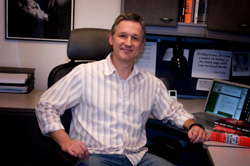
Earlier, you talked about how books and movies are different mediums. With Saints and Soldiers you did a documentary before you made the feature film, and with the subject of Helmuth Hübener you’re doing the same thing—a documentary and now a feature film. What makes you come back to this same source material from these different approaches?
It was a different situation for each of those two examples. For Saints and Soldiers, I had done the documentary Saints at War, and then Ryan Little and Adam Abel, the director and producer of Saints and Soldiers, came to me. They were interested in the idea of telling a World War II story and having some LDS characters intermixed with other characters. So we took some true stories from the documentary that I had done and interwove those with other true stories that we were aware of to create a storyline that was based on actual events, but was, at its essence, a fictionalized story. So, that was one where I had done the documentary and thought I was done with it, and they came back to me and said, “Hey, we want to make a film about this. Are you interested?”
With Truth and Treason, the Helmuth Hübener story, I did the documentary, and the story wouldn’t let go of me. And that’s one where while I was editing the documentary I started writing the screenplay to adapt it into a feature film. Every once in a while a story just takes control and you have to tell it.
How did you come across the Helmuth Hübener story?
It was when I was working on Saints at War and I had interviewed a German member of the Church who had served in Hitler’s army. I was fascinated by that perspective of what it was like to have grown up in that environment, to have served on that side, and to be an active member of the Church.
So while I was doing that, another associate of mine, Rick McFarland, approached me and said, “Hey, have you ever heard of the Helmuth Hübener story?” He had served his mission in Germany and was familiar with the story. I told him that I was vaguely aware of it. He said, “I think that one of these resistance fighters is still alive. I think he lives in Salt Lake. Let’s see if we can find him.”
I think we actually just opened up the phone book and looked up Karl-Heinz Schnibbe and there he was. We called him on the phone and said, “We’re interested in your story. Could we come and meet with you?” He said, “Of course.”
He invited us up and we sat down in his house and he told me the story and I was just blown away. I was astounded by the story that this sweet, little old man had to tell about what they had done when they were sixteen, seventeen years old. I spent a lot of time with Karl. I took him back over to Germany, to Hamburg where it had happened, inside some of the cells where he was held. Some of them were still in existence. It was just a very powerful experience. His friend Helmuth was executed, was beheaded by guillotine.
We went back to that site where he was executed in Berlin, which is now a national memorial, and were actually in there with Karl. And while we were there this busload of German high school kids came out on a fieldtrip.
So we’re filming with Karl while they’re kind of wandering around and there’s a photo of the Helmuth Hübener group on the wall and one of my crew was talking to the teacher of these kids and pointed to the photo of Karl as a seventeen-year-old and said, “You see that kid? That’s him right over there.” And he pointed to Karl as the old man standing there. The teacher’s jaw dropped and he immediately gathered all of his students around and said, “Tell us your story.”
I stepped back and watched Karl as he was talking to kids who were sixteen and seventeen years old—the age he was when he was fighting against Hitler—and I was watching the kids, watching their wide eyes, and I saw that some of them were getting it. That it was getting inside.
There were tears in their eyes, and that was when I realized that this story was more than just a little PBS documentary. This was a story that could really speak to a worldwide audience. That’s when I came back and really started in earnest working on the screenplay.
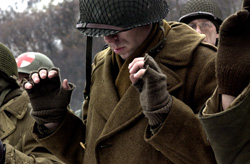
What’s your favorite project so far?
It’s hard to say. I’ve been working on this and nothing but this for the past four and a half years. But as far as favorite projects that are finished, that are out there, I’m very self-critical of the work that I put out.
One project that I could say that I’m proud of is actually a documentary I did for PBS called Small Fortunes. It was an incredible experience filming it, and the end product—again, when I watch it I see everything that’s wrong with it—but in that one I can also see that there’s a lot that does work.
And I’ve seen that it’s actually had an impact. That’s rewarding.To make a movie, to tell a story and have it have an impact, actually change the way people live their lives, that’s rewarding.
Is that an idea that you came up with or were you approached for Small Fortunes?
I was approached by a friend that I work with, another filmmaker, who asked if I had ever heard of Muhammad Yunus, and I hadn’t.
And he said, “Well, have you ever heard of microcredit?”
“Vaguely,” I said.
He explained to me what it was. “Muhammad Yunus is this Bangladeshi man who is kind of seen as the father of the microcredit movement. He’s going to be in Salt Lake. I think I can get a short interview with him if you’d like it.”
I said, “What the heck, let’s do it.”
When I got the camera crew and went in to interview him I didn’t even know what questions to ask him, so I had to ask somebody who knew more about him and the microcredit movement to tell me the questions to ask him.
He walked into the room—and this is a man who’s not Christian, he wasn’t raised Christian or anything—and the light of Christ just shone from his countenance.
This was somebody who had dedicated his whole life to feeding and helping the poor help themselves out of extreme poverty.
I came away from that thinking, “We’ve got to do more with this. This is incredible.”
It was in conjunction with BYU Television—they had actually wanted to make a documentary about the same thing—so we joined together on that and shot it in 2004 in India and Bangladesh, then the Philippines, Kenya, Mexico, Peru, and throughout the United States. It was just unbelievable—an incredible experience.
Your current project is the Helmuth Hübener project. Are you looking at other projects or is that your main focus?
I have other scripts that are at various stages, but now I am wholly focused on telling the Truth and Treason story.
I have tentative plans for some projects that I may want to do after this, but quite frankly, I am so focused on this that I’m going to get this story told and then we’ll see what happens after that.
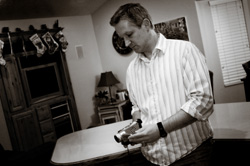
Taking an idea from the conceptual stage to the finished project is an immensely long process. Can you tell us where you are and where you hope to take it in the near future?
We are in a stage right now that’s called development where we have a screenplay that we are very pleased with. Of course it’s always evolving; everyday I’m still working on it. But it’s to a point where we feel comfortable sending it out to actors to see if we can attach actors to certain roles and get those in place as we go forward, trying to raise the money to make a fairly large independent film.
We’re to the point now where we have some really good actors attached, and we have some great Academy Award-nominated and Academy Award-winning crew on board. And we’ve got about half of our financing in place.
The plan is to finish that out and be able to shoot this summer or this fall in Budapest. We’ll be filming in Budapest. The events took place in Hamburg but we can’t shoot it there. Hamburg was leveled in 1943, just a year after Helmuth was executed, and later rebuilt, but it’s difficult to film there. It doesn’t look like it used to; it’s very modernized.
After scouting a lot of different European countries we landed in Budapest and found that it’s a beautiful city; it actually looks a lot like 1941 Hamburg and it was the right place to shoot.
So we’ve partnered with a production company that’s based in Budapest and are in the process now of pulling together the remainder of the financing, pulling together the right team members, the right cast, and getting ready to go.
How involved has Karl-Heinz Schnibbe been in this process?
Actually quite involved. It’s been great—what a blessing. I was just working on a scene where we have Helmuth in his cell the night before he is going to be executed, and I thought, “What was it really like?”
So I called him up and asked, “Karl, what do you know about where Helmuth was?”
And he said, “He would have been handcuffed to the wall. One of his arms was always handcuffed to the wall, so if he tried to stand up, he couldn’t stand up completely.”
I don’t where else I would have found a detail like that that, but I called Karl up because he was in some of those cells. He was arrested by the Gestapo, he was tortured by them.
Again, when I was writing an interrogation scene with the Gestapo, I just called up the man who was interrogated by them and said, “How did this work?”
And he said, “Well, what they would do is one would sit on this side of the room and one would sit on the other, then they would fire questions at you and you had to look back and forth at both of them. It was to rattle your brain.” These are just incredible, beautiful details that we have because he was there.
Are you an artist who happens to be a Mormon or a Mormon who is also an artist?
To a certain extent I think that’s just semantics. I’m a Mormon who’s aspiring to be an artist. I know that my faith informs my work, but I also feel that my work informs my faith. I feel that these projects that I’m working on have strengthened my faith.
And not just LDS-themed projects, or projects that have LDS ties to them. My faith was strengthened by working on the Small Fortunes project, but I also do feel that my faith strengthened that project.
So, it’s hard for me to separate the two. It really is a conflation of those two ideas of work and faith. I know that being Mormon helps me be a better storyteller, a better filmmaker.
It may seem to be at odds because there are a lot of movies that I won’t go see, that everyone in the business tells me I have to see. I made a decision early on that there are certain films that I’m not going to go see and I don’t go see them.
That can be a drawback in trying to be a well-rounded filmmaker and storyteller. However, the benefits that my faith brings to me as a storyteller and as a filmmaker far outweigh any drawbacks that may come.
Just the upbringing that I’ve had, and frankly the strength of the Spirit—learning how to follow those really subtle promptings, which, throughout our life we’re taught. When you’re on the set and working with an actor and being able to discern if there was truth communicated in that performance or if there was a little bit of falseness to it, I rely not only on my talents and abilities, but I rely on the Spirit to do that. So as an LDS filmmaker I know that it helps me.
You are an active member of the Church and are very successful in a field that isn’t always seen as Mormon-friendly. How do you think that the work that you do helps build the kingdom?
I don’t know that any film will change the world. I doubt that any one film will. But there is real power in telling good stories, whether it’s on film, or in a book, or around a fire. There is real power in story.
I aspire to be able to tell good stories that will move, that will entertain, but that will also edify.
Let’s just go out and tell good stories, and if there are Mormon ties to them, great. If not and they’re good stories, great. Let’s tell good stories and see if we can affect some people. ❧
